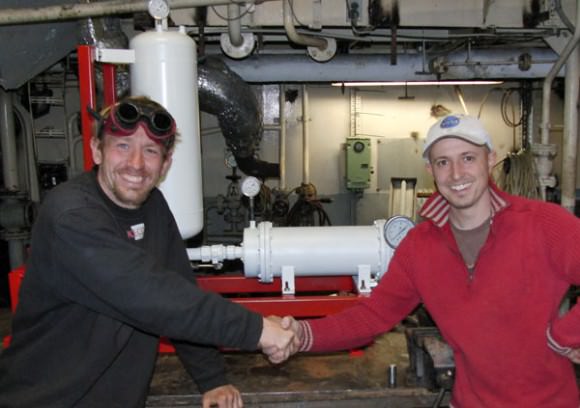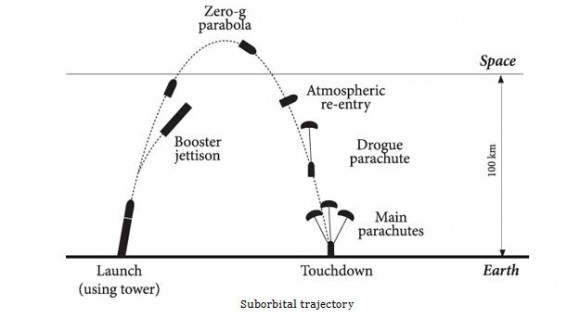[/caption]
It’s something like the movie “Astronaut Farmer,” but this is for real. And it’s in Danish. Copenhagen Suborbitals, headed by Kristian von Bengtson and Peter Madsen, hope to launch the world’s first amateur-built rocket for human space travel. As of this writing, the launch countdown clock on the Copenhagen Suborbitals’ website reads 7 days and 12 hours, which would put the launch on August 30 at about 1300 GMT. This upcoming flight will be an unmanned test flight, but if all goes well, Madsen hopes to be inside the single-passenger capsule named Tycho Brahe for a manned flight in the near future. They have a sea-launch site on the Baltic Sea near Bornholm, Denmark, and their HEAT 1-X rocket is ready to go.

The team has been building their hybrid rocket since about 2004. Copenhagen Suborbitals is a non-profit endeavor, based entirely on sponsors and volunteers. Their mission: launch a human being into space. If they are successful, Denmark would become only the fourth nation to send a human into space. But this project is completely private – no national funds have been used. “We are working fulltime to develop a series of suborbital space vehicles – designed to pave the way for manned space flight on a micro size spacecraft,” said Madsen and von Bengtson on their website.
The Hybrid Exo Atmospheric Transporter or HEAT, is their booster rocket. It stands about 9 meters high, and it is a real scale rocket with a 640 mm diameter tube and uses liquid oxygen (LOX) for fuel. The HEAT booster will burn for about 60 seconds, providing 40kN of thrust, resulting in less than 3-g making the trip feasible for humans to endure in an upright position.

The booster was successfully test-fired in February and May 2010. Copenhagen Suborbitals has also built three other rockets and successfully tested and flown them, including a small unmanned sounding rocket, named Hybrid Atmospheric Test Vehicle or HATV and smaller versions of the HEAT rocket.
“The mission has a 100% peaceful purpose and is not in any way involved in carrying explosive, nuclear, biological and chemical payloads,” said Madsen and von Bengtson.“We intend to share all our technical information as much as possible, within the laws of EU-export control.”
Previously, Madsen built the world’s largest home-made submarine, UC3 Nautilus. von Bengtson used to work for NASA. “This is the wildest thing I’ve made,” said Madsen in the Danish publication B.T. It is much wilder than the submarine.” Madsen added that he was tired of waiting for NASA, so decided to build a rocket himself.
The Tycho Brahe capsule is a single passenger capsule with a full view through a polymer plexiglas-dome so that the person can see and experience the entire ballistic ride. It has a pressurized volume providing support for one upright standing/half-sitting person. It will also have additional pressurized space, around and behind the astronaut, available for several other systems necessary for the flight procedure, and to support additional scientific and commercial project.

Copenhagen Suborbitals is taking donations, so check out their website. There’s also lots of images and videos available, on the site, too.
Since I am of one-half Danish heritage, I find this especially exciting. We’ll be following the progress of the Copenhagen Suborbitals’ historic flight. Stay tuned!


“…if all goes well, Madsen hopes to be inside the single-passenger capsule named Tycho Brahe for a manned flight in the near future…”
This will end well.
One man, one dream, one rocket. But it only takes one fail. (And that engine test was scarily uneven.) As if Denmark wasn’t flat enough already.
That said, I keep my boosters straight (crossed? whatever) for such guys.
I hope it goes well.
The Astronaut Farmer wasn’t a great movie, but it was okay.
jeesshh, the thing even looks like an Estes Rocket!
Well, good luck to them, Hope it works, be nice to have some new members of the “Been to space” club.
Lets hope they’ve got the re-entry heat thermal analysis on the polymer plexiglas-dome right! Ballistic trajectory an all… at what speed?
Lessee here: 1 g = 9.80665 m/s^2, so 3 g = 29.41995m/s^2 for 60 seconds = 1765.1970 m/s or 3948.6332 mph!
In comparison the SR-71 Blackbird spy plane flew at close to 2,200+ mph and experienced some +700 deg. F temps along it’s engine intakes, forward wing sections and fuselage.
Correction to article.
“Copenhagen Suborbitals has also built three other rockets and successfully tested and flown them, including a small unmanned sounding rocket, named Hybrid Atmospheric Test Vehicle or HATV and smaller versions of the HEAT rocket.”
Copenhagen Suborbitals has not flown any rocket so far, we have made around 18 static test, of different sizes and fuel, but HEAT 1X will be the first one to fly,
Regards
Jesper Jev Olsen
CS Team member
This project is completely barmy. I really like it!
Wow – I’m not sure I’d post a video of a rocket motor test like this. I build solid propellant rocket motors (hardware and propellant) as a hobby for large-scale model rockets, and I’d consider a test firing like this something of a failure. There were obvious low pressure signs during at least the last half of the burn, and I’m not sure this motor ever really came up to pressure properly. I’d have to guess that the Isp (specific impulse) on this motor was below what a good black powder motor delivers (70 or 80) and nowhere near the 200 to 230 level you’d be shooting for with a composite / AP motor. And reliable composite boosters will be very simple to build when compared to the main liquid propellent motor. (Yikes!)
I wish these guys the very best of luck, and I certainly hope and pray that no one gets killed or injured in their flight attempt.
I’m going to assume that the Copenhagen Suborbitals video was of an ‘early’ test? Perhaps~ they don’t want the competition to know how far along they actually are?
@Copenhagen Suborbitals… Hey fellers an Gals~ What up over thar? Bet you are being watched from every angle?Dzzzzz… Whateber… I would like to applaud your ‘pioneer’ spirit and ‘go for it’ attitude! MORE of that por favor!
One of my favorite expressions is: “He and/or She who goes there… knows there!” .
The one problem I can see with this is the g-force will pull blood away from the brain. So the passenger might reach suborbital flight in an unconscious state. Most other craft have the g-force against the back which prevents this. Maybe 60 seconds of this is not enough to induce unconsciousness.
Another question is what is the puprose of a submarine? A surface craft seems much more reasonable and cheaper.
LC